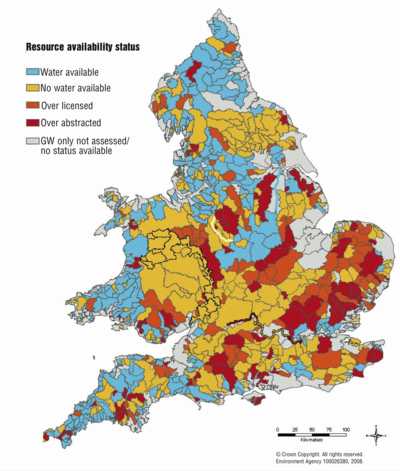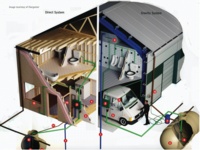Rainwater Harvesting — saving the UK’s water

The cost effectiveness of water harvesting — Steff Wright.
Over 100 000 l of water falls each year on the roof of an typical 4-bedroom family home in the UK, compared with the 70 000 l a year used by a typical family for flushing toilets, washing clothes and outside use. Harvesting that water is the solution to the water stress that is experienced in much of England, explains Steff Wright.With rainfall per capita in the south of England less than that experienced by most Mediterranean countries and population predicted to continue growing, the availability of water supplies can no longer be taken for granted when planning new developments. National response to this approaching crisis has been to encourage water economy — a wise strategy bearing in mind that this is the only realistic way of reducing water consumption in the country’s stock of existing homes, factories and commercial premises. How effective this strategy has been can perhaps best be gauged by a glance at the latest Environment Agency map of areas of relative water stress. This map shows that all English water authorities south of the Humber, excepting only Bristol and Wessex, are experiencing either moderate or serious levels of water stress — predominantly the latter. Reflecting the potential seriousness of this situation, water companies have now become part of the approval process for all significant new developments. If the water cannot be supplied, how can approval be given? This dilemma is also reflected in the Code for Sustainable Homes, which will progressively become mandatory through legislation over the next few years. The lower levels of the code (1 and 2), demand that household water consumption (currently around 150 l per person per day) be brought down to no more than 120 l, a requirement that can usually be met by installing smaller/dual-flush toilet cisterns plus aerated taps and shower-heads. However, it is anticipated that quite quickly houses built to this standard will no longer be acceptable, as code levels 3 and 4 becoming the norm. At code levels 3 and 4, water consumption requirement must be reduced to a maximum of 105 l per day, which could be achieved by simply installing smaller baths. However, for many consumers this might well be an unpopular option, leaving developers to search for a cost-effective alternative. By the time code levels 5 and 6 are demanded, the maximum allowed water consumption comes down to only 80 l per person per day — a 47% reduction on today’s norm and which cannot realistically be achieved by water economy measure alone. Needless to say, we use water at work as well as at home, so similar constraints on commercial developments are predictable. An elegant answer to this practical problem is rainwater harvesting, which has been popular for many years in Germany and which has increased its market 10-fold in the UK over the last four years. Even so, the German market remains about a hundred times the size of that in the UK, leaving plenty of scope for further growth in England’s water-stressed areas. Harvesting rainwater was one of the principal sources of household water prior to the Victorian development of the mains-water distribution system. Whether used in domestic or commercial applications, the working principles for most rainwater harvesting systems remain the same, with all operations entirely automatic from a user’s perspective. It is also indistinguishable from using the mains supply for the same application. Rain falling on the roof is routed via normal guttering and down-pipes to a single collection point, with any solid matter filtered-off before the water enters a storage tank. Ideally, the tank should be underground, where the cool and dark conditions will help to maintain water quality. Harvested rainwater can be used for non-potable applications such as flushing toilets, washing clothes, watering the garden and washing cars. In domestic-use, such applications account for around half of all household water consumption and over 80% in commercial buildings (due to the different water-usage patterns compared to dwellings) that combine a large roof with a high demand for non-potable water.

Data from the Environment Agency clearly shows the pressure on water resources, including both ground water and surface water, in England and Wales.
The payback period on systems for buildings with larges roof and high non-potable water use is about three years. Rainwater harvesting systems also integrate elegantly with site storm-water management arrangements. Where attenuation is required, it can most cost-effectively be achieved by installing suitably sized tanks with an internal weir that separates the harvesting and attenuation sides of the system. Where required, a second weir inside the tank can similarly reserve a desired quantity of water for a sprinkler system or fire-fighting appliances. Unlike their pre-Victorian predecessors, modern rainwater harvesting systems are entirely automatic and operated by management systems that ensure continuity of supply during prolonged dry spells. They are also designed to be simple to install, easy to maintain and, above all, highly reliable. By far the easiest way to make sure that site operational requirements are fully met, cost-effectively and in accordance with relevant legislation, is to seek a free preliminary design and budget quote from a reputable specialist supplier, such as those in membership of the UK Rainwater Harvesting Association (see www.ukrha.org). In summary, rainwater harvesting is an extremely old and simple concept that is now coming back into fashion driven by the pressures of diminishing mains-water supplies, evolving building standards, and the need to control storm-water run-off. Modern technology and systems offer a highly cost-effective solution to these problems in both commercial and domestic applications, whilst at the same time retaining water on-site for productive and safe use. They also save wasting the resources needed to bring water up to drinking standard and transport it to the consumer — only to then use it to flush toilets or water the lawn! Steff Wright is chairman of the Gusto Group of Companies. He has been involved with the rainwater-harvesting industry for 10 years and is a founder member of the UK Rainwater Harvesting Association.

Harvesting rainwater significantly reduces the demand for mains water in both domestic and commercial installations, as illustrated here by Klargester products.
Related links:
Related articles:










